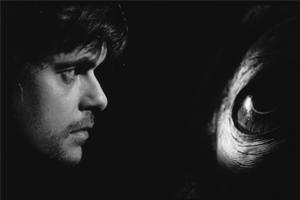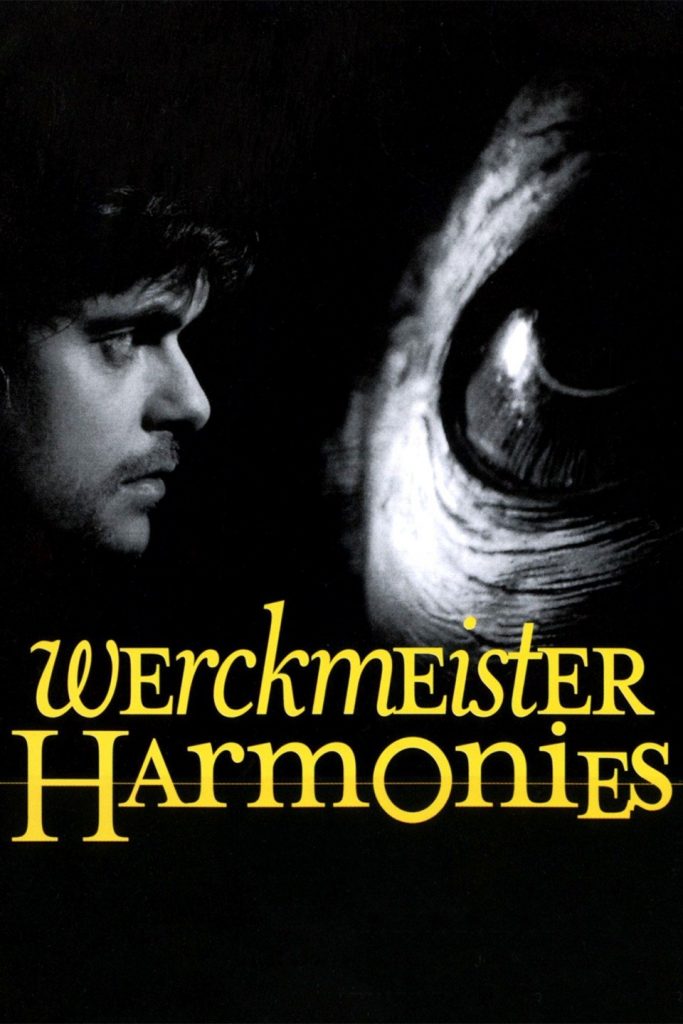Béla Tarr’s Werckmeister Harmonies (2000), based on László Krasznahorkai’s 1989 novel The Melancholy of Resistance, sees the arrival of an enormous taxidermy whale in a small Hungarian town. Local postman János, played by the wide-eyed Lars Rudolph, becomes fascinated by the displaced beast, seeing the divine beauty and awe of God’s creation in its rotting carcass. Others in the town fear the ominous arrival of the whale and its small circus group, discussing ‘plagues’ and showing increasing concern for the safety of the town.
The ‘blasphemous’ circus and its ‘stinking monster’ take residence in the large square in the centre of the town and sit silently and patiently as crowds begin to gather. Eventually, the tacit influence of the circus and its unseen ‘Prince’ inspires civil unrest as the working classes smash shop fronts, start fires and wreak havoc in a hospital. János is unseen until the aftermath of the riot where he is told to leave town as he is wanted for his part in the protests. Tracked down by a menacing helicopter, János is committed to a mental institution where all optimism and wonder seem to have been drained from him. His uncle György, having spent the film trying to oppose the ‘repressive’ musical scale developed by the titular Andreas Werckmeister, senses defeat following the failed uprising and stands in the square staring into the dead eye of the decomposing whale, now exposed to the stark fog settling on the town.
Tarr’s infamously impenetrable films have seen the auteur regularly wrestle with complex themes and philosophies. His consistently slow-paced and uncompromisingly long takes (of which there are just thirty-nine in Werckmeister Harmonies’ 145 minutes) have earnt Tarr the rightful position as a grand master of European cinema. The repeated use of animals in his work is often difficult to analyse symbolically, as the director insists that there are no allegories in his films. Tarr’s cinema does, however, invoke an important relationship between the human and the animal – often unveiling a point of extremity in the human character, such as the troubling scene in Sátántangó where we see the drawn-out murder of a cat by its young owner.
Consistent with this reading of human-animal relations, Jacques Rancière proposes that ‘the animal inhabits Béla Tarr’s universe as the figure in which the human experiences its limit’.1 Rancière’s words here hint at the sublime, which certainly holds true for Werckmeister. The first glimpse of the whale’s presence comes with a low-angle shot looking down a row of houses [Fig 1]. A large shadow precedes the truck carrying the animal and casts darkness over the entire street. The vehicle then proceeds slowly until its headlights are the sole source of light in an otherwise black frame [Fig. 2]. The camera then stays static as the truck takes thirty-five seconds to pass János, dwarfed by the immense metal sheeting surrounding the whale [Fig. 3]. The entire sequence lasts almost three and a half minutes, the awesome size of the whale appearing to engulf the town it has just slowly arrived into. János’ relationship with the ‘monster’ continues in a similar fashion upon his first real contact with the whale as his miniscule body stands bewildered, staring into one of the creature’s still eyes [Fig. 4]. The sublime evocation of the whale leads János to ponder ‘how great is the Lord’s creative impulse and power, and how omnipotence is reflected in that animal’. The whale presents itself as the divine threshold of the sublime, a corporeal manifestation of God’s omnipotence on earth and leaves the young man in total awe.
Despite Tarr’s insistence that ‘there are no metaphors, allegories or symbols in my films. We have one sole objective: to film reality’, some critics have sought to impress theories of reading Werckmeister Harmonies which cannot help but consider the animal-sign metaphorically.2András Bálint Kovács tantalisingly suggests that Tarr’s film follows a ‘metaphorical narration’, where ‘events and relations are impossible to explain on a concrete and practical causal level; they make sense only on metaphorical terms’.3 This absurdist (or even surrealist) approach to Werckmeister draws out some of the often difficult logic surrounding the political resistance showcased on screen. The resistance to structures of power is advanced on a meta-level, as the logical processes of narration and film-making themselves are subject to certain leaps of faith on the part of the viewer. These ruptures, I suggest, come about as a result of the absurd intrusion of the whale into the small town space. A security guard at an apartment block tells János that either ‘the whale’s got no part in it’ or ‘the whale’s the cause of it all’. The very presence of the huge, inert corpse leads to a revolution of thought and action, upsetting the order of things both within and outside of the image on screen.
The threat of revolution as posed by the circus, and the ‘frightening’ attraction of the whale is key to Werckmeister Harmonies. Rancière refers to the whale as ‘not an allegory [but] the agent of division between two orders’.4 János’ fascination with the cosmos, shown in the extraordinary first scene where he organises a group of drunken men in a pub to recreate the solar system, highlights his position in what Rancière terms the ‘mythological’ order.5 The whale, seen through János’ eyes, enters into the cosmological reign of the mythological, its immense corpse creating a rupture in the social-realist misery of the Hungarian town. János’ stupefaction in front of the whale is juxtaposed with the deep suspicion and hatred aimed towards it from other parties in the town. Rancière terms this second order that of the ‘social intrigue’.6 The civil unrest sparked by the circus’ arrival in the town is held to be the work of the ‘Prince’, who is only seen by his silhouette and modified, robotic voice. Neither he, nor the taxidermy whale are exactly ‘animal’ but they are certainly not ‘human’. As such, their influence on the people of the town is all the more unsettling. Kovacs suggests that the immense size of the whale alone provokes such a reaction in the inhabitants that it ‘leads them to follow whatever ideology is presented to them’.7 A pessimistic reading of naive civil unrest, perhaps, but this consideration of the whale’s power in presence alone is noteworthy. The combination of the sublime, rotting whale with the infectious anti-establishmentarianism of the Prince rallies a vital and brutal attack on the conventional order that the chief of police and other structures in the town represent. However, the destructive nature of rebellion can only lead to the reinstatement of the old order, as the angry mob are unsure of what, or who, they are attacking. The whale is therefore a false prophet, inspiring rebellion that can only ever return the pre-established norm.
The threat of the outside is a recurring theme in Tarr’s work: from the ominous return of Irimiás throughout Sátántangó, to the invasion of the gypsies in The Turin Horse. Werckmeister Harmonies’ whale is no different, but the film deviates from Tarr’s usual style in its tracking of the singular plotline of an empathetic protagonist. János is presented as an outsider himself, and although I am certain that it would cause Béla Tarr great displeasure to hear it, he could be read as a filmic manifestation of Tarr’s radical approach to film-making. John Hodgkins suggests that, in using the outsider figure of the whale, ‘[Tarr] gives the past a corporeal form, drags it into the town square, and lets his characters poke and prod it in a search for present meaning’.8 Whilst I am not necessarily convinced by the attempts of Hodgkins and others to imbue the whale with a certain sentimentality or longing for a Hungary whose political system is now bloated and helplessly beached in a small, rural town, I do appreciate the implication of a othering, temporal value within the whale. Indeed, János’ visits to the whale are flanked by a two-to-three-hundred strong crowd surrounding the truck, stood perfectly immobile as if frozen in time. Gérard Grugeau suggests that the ‘image of the whale [is] linked to eternity’, cleverly probing the wordplay of János/Jonas and the whale (Jonas is the French name of the biblical character).9 This intertextuality aids the non-temporal nature of the outsider whale, removed from both its space (the sea) and time (its life).10
Werckmeister Harmonies , and its whale, are by all accounts strange and cumbersome beasts. The seemingly politically charged nature of the decomposing corpse of the whale leads to a (characteristically Tarrian) futile pursuit of meaning, for those both on the screen, and in the cinema auditorium. However, refusing symbolism and allegory, the whale brings simple poetic presence to the screen, dominating its frame and unsettling its logics.
[1] Jacques Rancière, Béla Tarr, The Time After, trans. by Erik Beranek (Minneapolis: Univocal, 2013), p.77.
[2] Gérard Grugeau, ‘Entretien avec Béla Tarr’, 24 images, 111 (2002), 42-44 (p.42) [My own translation].
[3] András Bálint Kovács, The Cinema of Béla Tarr: The Circle Closes (New York, NY: Columbia University Press, 2013), p.135.
[4] Rancière, p.54.
[5] ibid.
[6] ibid.
[7] Kovács, p.133.
[8] John Hodgkins, ‘Not Fade Away: Adapting History and Trauma in László Krasznahorkai’s The Melancholy of Resistance and Béla Tarr’s Werckmeister Harmonies’, Adaptation, 2 (2009), 49-64 (p.52).
[9] Gérard Grugeau, ‘l’Éclipse et l’éternité’, 24 images, 111 (2002), 44-45 (p.45) [My own translation]
[10] Rancière also points to the intertextuality of Tarr’s whale with regards to Melville’s Moby Dick (Rancière, p.53).
Bibliography
Grugeau, Gérard, ‘l’Éclipse et l’éternité’, 24 images, 111 (2002), 44-45
‘Entretien avec Béla Tarr’, 24 images, 111 (2002), 42-44
Hodgkins, John, ‘Not Fade Away: Adapting History and Trauma in László Krasznahorkai’s The Melancholy of Resistance and Béla Tarr’s Werckmeister Harmonies’, Adaptation, 2 (2009), 49-64
Klinger, Gabe, ‘Hope Deep Within – Béla Tarr’s Werckmeister Harmonies’, Senses of Cinema, 11 (2000), [accessed at: https://sensesofcinema.com/2000/eastern-european-cinema/tarr/]
Kovács, András Bálint, The Cinema of Béla Tarr: The Circle Closes (New York, NY: Columbia University Press, 2013, ‘The World According to Béla Tarr’, KinoKultura, [accessed at: https://www.kinokultura.com/specials/7/kovacs.shtml]
Rancière, Jacques, Béla Tarr, The Time After, trans. by Erik Beranek (Minneapolis: Univocal, 2013)
Romney, Jonathan, ‘Outside the Whale’, Sight and Sound (April 2003), [accessed at https://old.bfi.org.uk/sightandsound/review/1394]
Schlosser, Eric, ‘Interview with Béla Tarr: About Werckmeister Harmonies (Cannes 2000, Director’s Fortnight)’, Bright Lights Film Journal (October 2000), [accessed at: https://brightlightsfilm.com/interview-bela-tarr-werckmeister-harmonies-cannes-2000-directors-fortnight/#.VTZkf61Vikp]

